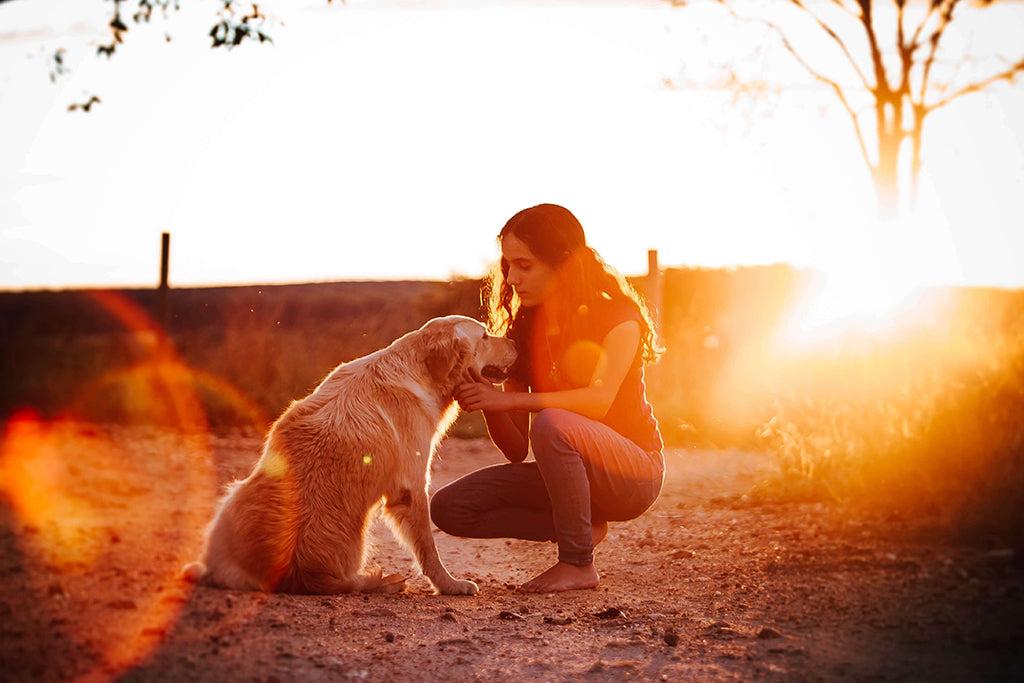When it comes to dog care, in this blog, learn the 12 most common mistakes pet owners make which they may not realize.
12 Harmful Mistakes You’re Making Without Realizing It!

Being a puppy parent has its ups and downs. Every poop pick-up, rainy walk, or stinky dog-breath kiss can be forgotten in a blink of a puppy dog eye the moment you see that waggy tail and happy face after a long, hard day.
Let’s face it, our pups are always there for us. They continuously help us to feel happy and loved, but it’s our job to make sure that we’re doing the best we can to keep our fur babies happy, healthy, and well – however, we could be making harmful mistakes without realizing it!
Take a look at 12 common ways we puppy parents can fall into bad habits…
Dog Care
1. Choosing The Wrong Collar
Something a simple as choosing your dog’s collar can go very wrong. And, unfortunately, if you get their collar completely incorrect, it could result in extremely stressful situations – for both you and your pup.
To start, there are lots of different types of dog collars, so you need to make sure you pick the right one for your pup and lifestyle;
- Flat collar: the most common type, with an adjustable buckle.
- Breakaway collar: made with a clip that comes undone if your dog becomes caught, to help prevent choking or hanging.
- Harness: fits around your dog’s chest and upper body to reduce strain on the throat and neck.
Each type of dog collar has its own pros and cons, so you need to decide which is best for your pooch and go from there.
Once you’ve picked the best type of collar, you then need to make sure that it is the right size. If the collar or harness is too big, your pup could slip out and escape – which will turn your relaxing walk into a stressful puppy hunt! This can be very dangerous, particularly if you live in a built-up neighborhood where there is a high chance of your pup getting hit by a vehicle.
Then, on the other hand, if it’s too small, the tight collar can cause discomfort, choking, and distress.
The correct fit all depends on your dog’s breed and size. If you have a small pup, you should always be able to slip one finger between the collar and your dog’s neck. For larger dogs, it is two fingers, rather than one.
PetLab Co. Top Tip: Keep checking the collar size with your fingers. Just like us, your dog can gain weight, so make sure the collar is always the right size and fit for your pooch.
2. Leaving Your Pup In The Car

You should NEVER leave your dog alone in the car. Even if you have the best intentions; cracking the window a little and saying you’ll be back ‘quickly’, could lead to an extremely poorly pooch, or worse – a fatality!
Did you know that the temperature of your car can rise in as little as 10 minutes? Within that time, the temperature can increase by 20 degrees – even if the vehicle is parked in the shade. According to PETA, on a 70°F day, the temperature inside the car can reach nearly 100°F in under 20 minutes, and on an even hotter, 90°F day, the interior can become as hot as 110°F within 10 minutes…
So, while you’re off on your errand, believing you’ll be back in no time, your pup will begin to struggle in potentially 110°F heat – which can be catastrophic for your pup.
Dogs don’t sweat like us, which means they can overheat a lot faster, and within 15 minutes, some animals have been known to sustain brain damage or die from the effects of heatstroke.
Symptoms of overheating include;
If you notice your pooch showing any of the signs above, it is imperative to seek medical help as soon as possible.
3. Physical Punishment
Of course, all dogs need training – but physical punishment is NEVER okay – it’s animal cruelty and it doesn’t work. Physically punishing your dog can actually do the opposite to what you want, as it’ll make your pup scared of you. They’ll start cowering, hiding, freezing, and urinating out of fear. You may think that you’re ‘teaching’ them, but in fact, your dog will only be thinking about how much pain they are in, rather than learning a lesson.
The best way to train your pup? Reward-based training – as it helps build trust between you and your fur baby, whereas physical punishment teaches your dog distrust in all humans, not just you. Reward-based training can encourage your dog to learn to behave in a more desired way – without creating fear.
Obedience school is a great option if you’re unsure how best to train your pup, as you’ll both learn together from an expert. The best time to train is when your dog is a puppy, as you’ll be able to install good behavior and learnings at an early age.
4. Letting Them Eat Everything!

Now, it can be very hard to fight those puppy dog eyes looking at your human food, but you have to be strong! Lots of our foods can be too salty, fatty, and spicy for our puppies, which can lead to painful health complications.
Xylitol is found in a lot of human foods; candy, ketchup, strawberries, and raspberries, and if your pup eats too much, it can cause their blood sugar to drop, potentially leading to liver failure.
Avoid the following;
- Alcohol
- Avocados
- Coffee
- Tea
- Grapes
- Raisins
- Milk
- Peaches
- Plums
- Raw eggs
- Chocolate
Also, if you’re someone who gives into puppy dog eyes easily, you’re actually encouraging a bad, learned behavior. Feeding your dog scraps during your own meal-time will teach them to expect food when you’re eating, which will then lead to negative behaviors such as begging. Try to avoid giving your dog food from your plate while you’re eating.
5. Neglecting Your Dogs Teeth
Imagine waking up in the morning and not brushing/flossing your teeth…then again, getting ready for bed and not brushing your teeth…would make you feel dirty, unclean, and very unhygienic, right? Just think of the bad breath!
Well, according to the American Veterinary Medical Association, 80% of dogs over the age of three have a form of dental disease, which can lead to serious health conditions. Why? It’s because only around 2% of dog owners actually brush their pup’s teeth.
Now, we know that a lot of our pups dislike having their teeth brushed, which can put us off the job altogether – as it means less stress for the both of you. But there are other ways you can support your pup’s oral hygiene without stuffing a brush into their mouths.
Our advice would be to start a dental hygiene routine while they’re young, as this will help them get used to the toothbrush, dental stick, or doggy mouth wash. Start by aiming for 3 days a week, but if you can do it every day, that would be even better. Plus, have your vet check your dog’s teeth at least twice a year, to help prevent serious health issues.
6. Going To A Dog Park Too Soon
When you have a new puppy join the family, it can be extremely exciting, but there are some things that need to happen a bit slower than others…
Taking your pup on their first walk is a huge step, as it helps to build the bond between you and your fur baby – and it’s the time where they will encounter other dogs.
Socialising is important, but starting them too early can be dangerous. If you take your new pup to a dog park too soon, it could result in rough play and injury. Dogs love to play fight, chase, and wrestle, which can be too much for your young furry companion. The larger, older dogs could cause fear and scare your pup, too. Not to mention the potential of contracting an illness from the other dogs. It is best to wait until your dog has all their immunizations and is old enough to join in with the playtime.
7. Your Dog Needs A Seatbelt Too!
This is one of the most common mistakes made by dog owners (myself included). When you think about it, you wouldn’t put a child in a car without a seatbelt, so why wouldn’t you do the same for your furry, four-legged child?
If you don’t secure your dog in the car – the worse could happen, so it’s always better to be safe than sorry. There are lots of different whys to keep your dog safe in your moving vehicle; harness seatbelts, zip-line harnesses, and different types of carriers to affix inside the car. Find the one that fits you and your pup best as soon as possible.
8. Too Little Stimulation

Dogs need constant mental and physical stimulation, especially the working breeds. If a dog doesn’t have enough stimulation, it can result in digging, chewing of furniture, and other destructive behaviors.
From training to chew toys, there are plenty of things you can do to make sure your pup is stimulated. Regular walking is a must! Walks provide exercise for both you and your pooch, but they also offer important sensory stimulation.
9. Yelling Or Shouting
Just like physical punishment (above), it doesn’t work. Your dog, especially when they’re young, won’t understand what words mean. Shouting “no” or “stop” won’t make sense to them, it’ll just cause them stress and confusion.
10. Skipping Flea/Tick/Worming Treatments
Preventative treatment is crucial as a puppy parent and should be paramount. If you stop or skip any of their flea or tick treatments, you could be leaving them vulnerable and without vital protection. Always listen to your vet and only stop treatment if they tell you to.
11. Access To Harmful Objects
Our furry friends are known for being adventurous and inquisitive – which can get them into all sorts of difficult situations. Try your best to dog-proof your house by simply putting away anything that they could chew or swallow; pills, batteries, magnets, screws and coins.
Now, when it comes to socks – all dogs seem to have a weakness for them! They just love to play, chew and hide them. However, if your pup eats or swallows even just a part of the sock, it can get stuck in their throat, which is extremely dangerous and could cause choking.
12. Neglecting Breed-Specific Needs
It’s never too late to get clued up on your dog’s breed. Whether you do it before you buy/adopt your pup or after you have them as a part of your family, learning everything you need to know about their specific breed will help a huge amount.
Lots of us can be guilty of doing neither, which can result in inadequate and incorrect grooming, training, and early health support. For example, if you have a Labrador Retriever you will need to know about common health issues that are more common within their breed, or a Basset Hound, which will require a specific grooming routine and regular ear and eye health checks due to their droopy skin and large floppy ears.
Sources
“Dogs in Hot Cars and on Hot Pavement” PETA https://www.peta.org/issues/animal-companion-issues/cruel-practices/dog-hot-car/
“Pet Dental Care” The American Veterinary Medical Association https://www.avma.org/resources-tools/pet-owners/petcare/pet-dental-care
 B
B



